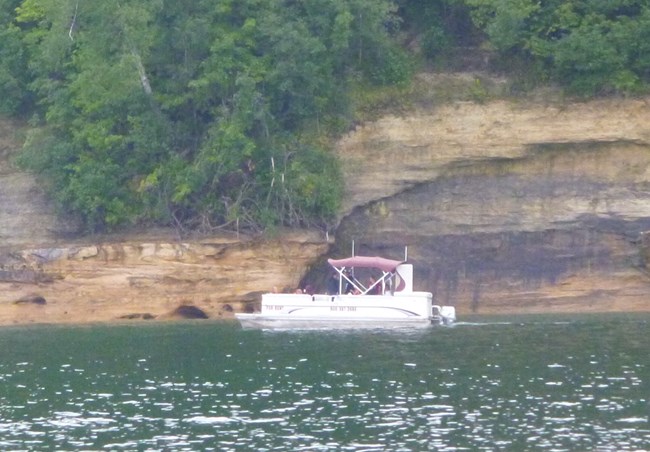
NPS photo Lake Superior's rugged shoreline invites boaters to explore the beautiful Pictured Rocks National Lakeshore with its miles of colorful sandstone cliffs and long stretches of sandy beaches. Peaceful inland lakes also invite boaters to linger in the northwoods. Know Before You Go!Check the marine weather forecast before venturing out. Watch the weather carefully while on the lake. The weather can change suddenly and unexpectedly. Just because it's calm in Munising Bay or Grand Marais Harbor does not mean it is calm along the more distant shores. Do you have the right kind of boat?Motorized BoatsBoats and motors of any size are permitted on Lake Superior. Horsepower is limited to 50 on Grand Sable Lake. Note: Only electric motors may be used on Little Beaver Lake and Beaver Lake in the Beaver Basin Wilderness.  Canoes & KayaksSea kayaks are the only kayaks equipped to go on Lake Superior. Canoes and recreational kayaks should NOT be taken out on Lake Superior. Lake Superior can be rough, and small craft are easily swamped. Instead take your canoe or recreational kayak to one of the park's beautiful inland lakes: Beaver Lake, Little Beaver Lake, and Grand Sable Lake. At Pictured Rocks National Lakeshore, we have responded to many rescues where kayakers were ill-equipped or ill-informed. Occasionally, kayakers will be properly prepared, and Lake Superior will still overwhelm them. We implore anyone interested in kayaking Lake Superior to seriously consider the risks and to properly prepare before getting in the water. Even experienced kayakers have been overpowered by the lake. Before you set out to kayak Lake Superior, ask yourself these questions:
(Inexperienced kayakers and those without their own kayaks can take a guided tour of the Pictured Rocks cliffs with authorized private companies. A list of authorized kayak and other commercial tour companies is on our Guided Tours page.) Do you have the right safety equipment to go out paddling?
2. Do you have the right safety equipment to go out paddling?
3. Can you save yourself?Help is not a phone call away! You are on your own! Alternative Places to PaddleYour decision on where to go paddling should depend on your type of boat, experience level of each person in your group, and the weather. Several inland lakes offer great paddling for recreational kayaks. Good choices that have a boat launch include:
Launching Locations for Lake SuperiorPersonal sea kayaks can be carried from parking lots to Lake Superior at these park locations:
Kayak CampingKayak camping at water-accessible backcountry sites is allowed at Pictured Rocks. HOWEVER, we strongly suggest you speak to a park ranger about kayak camping rules, regulations, and safety considerations before planning a trip. See the Backcountry Camping Planner (pdf) for more kayak camping information. As with all backcountry camping, kayak camping requires a reservation and a permit. Only certain designated sites are available for camping by boat. Sailboats & PaddleboardsLake SuperiorSmall sailboats and paddleboards can be launched into Munising Bay at Sand Point Beach. Munising Bay is a good place for sailing and paddleboarding since it is generally a more sheltered area. Larger boats should use the municipal boat ramps listed above to enter Lake Superior.
Inland LakesLittle Beaver Lake, Beaver Lake, and Grand Sable Lake are also suitable for small sailboats and paddleboards. Personal WatercraftPersonal watercraft (PWC) such as jet skis may travel within the lakeshore from the western boundary near Sand Point to the eastern end of Miners Beach. PWC are not permitted elsewhere within the lakeshore's 1/4 mile offshore jurisdiction along the Lake Superior shoreline. Water SkiingWater skiing is authorized on Lake Superior and Grand Sable Lake in accordance with state and federal laws. On Grand Sable Lake, horsepower is limited to 50. Other RegulationsBoats may pull up on beaches within the park, including beaches in the Beaver Basin Wilderness but pets are not allowed on beaches within the wilderness zone or any beaches east of Miners Beach to the western edge of Twelvemile Beach Campground. Pets are not allowed on Mosquito or Chapel Beaches. Pets are also not allowed in boats on Little Beaver or Beaver Lakes. 
Protect the Resources!It is crucial that we all work together to help limit the spread of invasive species to other, non-invaded bodies of water. Please:
Pictured Rocks National Lakeshore contains many pristine lakes and streams that are threatened by unwelcome visitors—invasive aquatic plants and animals. These non-native organisms can negatively impact wildlife habitat, upset the food chain, and out-compete native species. Hitchhikers spread from lake to lake by boat, trailer and fishing equipment, and expelled bilge water. Don't Have Your Own Boat?Check out commerical tours in the park!Boat RentalsPontoon boat and other rentals for use on Lake Superior are available in nearby communities. Check with local tourism organizations for information. more ... |
Last updated: October 1, 2024
